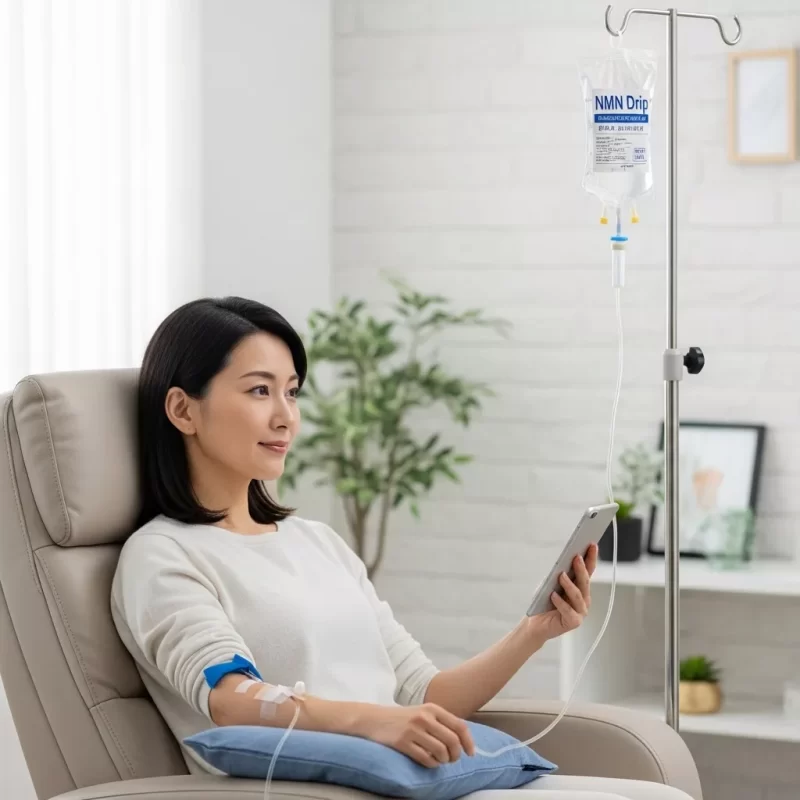NMN Capsule vs. IV Drip: Detailed Analysis of Operational Principles

NMN (nicotinamide mononucleotide), an important NAD+ precursor, has garnered significant attention in recent years for its anti-aging and health-promoting properties. This report will delve into the detailed operational principles of the two main forms of NMN administration—capsules (oral) and IV drips (intravenous)—to provide readers with a comprehensive scientific understanding.
Basic Introduction to NMN
What is NMN?
Nicotinamide mononucleotide (NMN) is a naturally occurring, bioactive nucleotide that serves as a key intermediate in the synthesis of coenzyme I (NAD+) in the human body. As we age, the level of NAD+ in the body decreases significantly, potentially dropping to about 50% of youthful levels by middle age. NMN supplementation is believed to effectively increase NAD+ levels in the body, thereby triggering a variety of beneficial physiological responses.
The Importance of NAD+
NAD+ plays a central role in cellular energy metabolism, DNA repair, gene expression regulation, and cellular stress response. It is an essential cofactor for the sirtuins protein family (known as “longevity genes”) and PARP enzymes, which are crucial in maintaining cellular health and delaying aging.

Operational Principles of NMN Capsules
Oral Absorption Mechanism
NMN capsules are primarily absorbed through the small intestine, a process involving specialized transporter protein mechanisms. A groundbreaking study in 2019 identified the SLC12A8 transporter protein, the first confirmed NMN-specific transporter.
Mechanism of Action of the Slc12a8 Transporter Protein
The SLC12A8 transporter protein is highly expressed in the small intestine and can specifically recognize and transport NMN molecules. This transport process has the following characteristics:
- Sodium Ion Dependence: NMN transport requires the participation of sodium ions, which distinguishes it from other SLC12 family members
- Rapid Absorption: After oral administration of NMN, a significant increase in NMN levels in plasma can be detected within 2.5 minutes
- Tissue Specificity: The expression level of SLC12A8 in the small intestine is approximately 100 times higher than in the brain or adipose tissue
Metabolic Pathways and Transformation
After oral NMN enters the body, it undergoes a complex metabolic transformation process:
First-Pass Effect
Oral NMN undergoes first-pass metabolism in the liver, where most of the NMN is converted to nicotinamide (NAM). Although this metabolic pathway reduces the efficiency of direct utilization, NAM can be resynthesized into NAD+ through the salvage pathway.
NAD+ Synthesis
Within cells, NMN is converted to NAD+ through the catalytic action of NMNAT1, NMNAT2, and NMNAT3 enzymes. These enzymes are located in different cellular compartments:
- NMNAT1: Primarily located in the nucleus
- NMNAT2: Primarily located in the cytoplasm
- NMNAT3: Primarily located in the mitochondria

Bioavailability of Oral NMN
Studies have shown that the bioavailability of oral NMN is affected by several factors:
- Dose Effect: At doses of 300mg, 600mg, and 900mg, the increase in blood NAD+ concentration did not show a clear dose-dependent relationship
- Individual Differences: There are significant differences in the absorption and metabolism of NMN among individuals
- Influence of Gut Microbiota: The composition of the gut microbiota may affect the metabolic efficiency of NMN
Operational Principles of NMN IV Drip
Intravenous Administration Mechanism
Intravenous drip administration directly injects NMN into the bloodstream, completely bypassing the absorption process of the digestive tract and the first-pass metabolism of the liver. This method of administration provides a more direct and efficient route to increase NAD+.

Advantages of Intravenous Administration
Rapid Absorption and Distribution
After intravenous injection of NMN, the drug immediately enters the bloodstream, and a significant increase in NAD+ levels can be detected in various tissues within 15 minutes. Studies show:
- Brain Penetration: Although NMN itself cannot directly cross the blood-brain barrier, intravenous administration can significantly increase brain NAD+ levels
- Tissue Distribution: NMN is rapidly distributed in multiple organs such as the kidneys, liver, and heart
- Sustained Effect: After a single administration, mitochondrial NAD+ levels can remain elevated for more than 24 hours
Avoidance of First-Pass Metabolism
A key advantage of intravenous administration is that it avoids first-pass metabolism in the liver, allowing more intact NMN molecules to directly participate in NAD+ synthesis. This method is particularly suitable for situations requiring a rapid increase in NAD+ levels.
Clinical Application Experience
According to clinical practices in Japan and other regions, NMN drip therapy typically uses the following parameters:
- Dosage Range: 100-500mg per session
- Administration Time: 15-60 minutes
- Treatment Frequency: Once every 1-4 weeks
- Safety Monitoring: Requires supervision by professional medical personnel
Detailed Comparison of the Two Administration Methods

Pharmacokinetic Differences
There are significant differences in the pharmacokinetic characteristics of the two administration methods:
Time to Peak and Peak Concentration
- Oral: Plasma NAD+ concentration typically reaches its peak in 1-3 hours
- Intravenous: NAD+ concentration reaches its peak within 15 minutes to 1 hour, with a higher peak value
Bioavailability
Clinical comparative studies have shown that intravenous administration of NR (an NAD+ precursor similar to NMN) has higher bioavailability than oral administration, with a 20.7% increase in blood NAD+ concentration, significantly better than the oral group.
Safety Assessment
Oral NMN Safety
Multiple human clinical trials have confirmed the good safety profile of oral NMN:
- Acute Toxicity: Single oral doses as high as 1250mg did not show significant adverse reactions
- Long-Term Use: No serious side effects were found with continuous use for several months
- Common Reactions: Occasional mild gastrointestinal reactions, such as nausea and diarrhea
Intravenous NMN Safety
Safety data for intravenous administration is relatively limited, but preliminary studies show good tolerability:
- Acute Reactions: Mild vascular pain or tingling may occur during administration
- Inflammatory Markers: Compared to intravenous NAD+ administration, intravenous NMN administration causes fewer inflammatory reactions
- Medical Supervision: Requires a professional medical environment and personnel monitoring
Mechanism of Action at the Cellular Level
Sirtuin Activation Pathway
After NMN increases NAD+ levels, it primarily exerts its anti-aging effects by activating the sirtuin protein family. Sirtuins are NAD+-dependent deacetylases involved in regulating:
- Energy Metabolism: Promoting mitochondrial biogenesis and function
- DNA Repair: Enhancing cellular DNA damage repair capabilities
- Anti-Inflammatory Response: Reducing the release of pro-inflammatory cytokines
- Cellular Senescence: Delaying the process of cellular senescence

PARP Activation and DNA Repair
NAD+ is also an essential cofactor for PARP (poly ADP-ribose polymerase), an enzyme that plays a key role in DNA repair. A Harvard University study showed that NMN treatment significantly reduces age-related DNA damage and enhances cellular resistance to radiation damage.
Mitochondrial Function Improvement
NMN supplementation can:
- Increase ATP Production: Improve mitochondrial respiratory chain function
- Reduce Oxidative Stress: Activate antioxidant enzyme systems through SIRT3
- Improve Mitochondrial Dynamics: Reduce excessive mitochondrial fission
Future Research Directions
Current research focuses on:
- Personalized Treatment: Personalized dosing regimens based on genotype and gut microbiome
- Synthetic Biology: Using engineered strains to mass-produce high-purity NMN
- Combination Therapy: Exploring the synergistic effects of NMN with other anti-aging interventions
- Long-Term Safety: Conducting large-scale, long-term human safety studies
Summary and Recommendations
NMN’s capsule and IV drip administration methods each have their unique operational principles and applicable scenarios. Oral administration is convenient and safe, suitable for daily health maintenance; intravenous administration is faster and stronger, but requires a professional medical environment. Both methods can effectively increase NAD+ levels in the body, triggering multiple beneficial physiological responses, including improving energy metabolism, enhancing DNA repair capabilities, and delaying cellular senescence.
For those interested in trying NMN supplementation, it is recommended to:
- Choose Authentic Products: Ensure product quality and purity
- Consult Professional Advice: Especially when considering intravenous therapy
- Personalized Plan: Adjust dosage based on individual health conditions
- Continuous Monitoring: Regularly evaluate effectiveness and safety
With the deepening of related research, NMN is expected to become an important tool for delaying aging and promoting health, providing new possibilities for extending human healthspan.


.jpg)